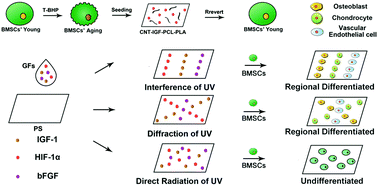Retracted Article: Growth factors regional patterned and photoimmobilized scaffold applied to bone tissue regeneration†
Abstract
Bone diseases such as osteomalacia, osteoporosis, and osteomyelitis are major illnesses that threaten the health of human. This study aimed to provide an idea at the molecular level of material properties determined with UV specific surface approaches. The tert-butyl hydroperoxide (t-BHP) exposure aging model bone mesenchymal stem cells (BMSCs) were reverted by using a poly-hybrid scaffold (PS), which is a carbon nanotube (CNT) coated polycaprolactone (PCL) and polylactic acid (PLA) scaffold, combined with insulin-like growth factor-1 (IGF). Then, the region-specific PS photo-immobilized with different growth factors (GFs) was obtained by interference and diffraction of ultraviolet (UV) light. Additionally, the reverted BMSCs were regionally pattern differentiated into three kinds of cells on the GF immobilized PS (GFs/PS). In vivo, the GFs/PS accelerate bone healing in injured Sprague-Dawley (SD) rats. The data showed that GFs/PS effectively promoted the differentiation of reverted BMSCs in the designated area on 21st day. These results suggest region-specific interface immobilization of GFs concurrently differentiating reverted BMSCs into three different cells in the same scaffold. This method might be considered as a short-time, low cost, and simple operational approach to scaffold modification for tissue regeneration in the future.



 Please wait while we load your content...
Please wait while we load your content...